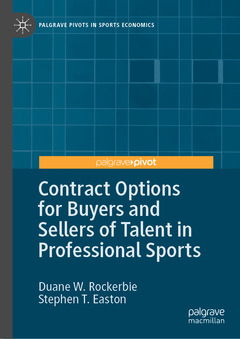Description
Contract Options for Buyers and Sellers of Talent in Professional Sports, 1st ed. 2020
Palgrave Pivots in Sports Economics Series
Authors: Rockerbie Duane W, Easton Stephen T.
Language: English
Subjects for Contract Options for Buyers and Sellers of Talent in...:
63.29 €
In Print (Delivery period: 15 days).
Add to cart
Publication date: 09-2020
97 p. · 14.8x21 cm · Hardback
97 p. · 14.8x21 cm · Hardback
Description
/li>Contents
/li>Biography
/li>Comment
/li>
This Palgrave Pivot re-examines salary formation in Major League Baseball in light of real option theory to clarify the connection between salary and marginal revenue product for professional baseball players. Current literature has tended to treat single-year and multi-year contracts similarly, ignoring the potential option value for teams and for players. Recent work points to the observation that both high-productivity and low-productivity athletes have salaries that systematically differ from their marginal revenue product, and that free agents signing multi-year contracts are overpaid relative to free agents signing one-year contracts. This book argues that the value of signing an athlete to a contract should be determined similarly to the determination of the value of an investment project or a financial asset. This book demonstrates how to calculate the value of real options to the player and the team owner with a simple two-year contract, and offers extensions to the realoptions model for multiyear contracts or when a player is early or late in his career.
Chapter 1. On the Rise: Player compensation and multiyear contracts.- Chapter 2. The puzzle of overpaid and underpaid players.- Chapter 3. Contract Options for Buyers and Sellers of Talent.- Chapter 4. Extensions to the put option model.- Chapter 5. Concluding remarks.
Duane W. Rockerbie is Professor in the Department of Economics at the University of Lethbridge, Canada. He is a member of the editorial board of the Journal of Sports Economics and is a past Vice-President of the North American Association of Sports Economists (NAASE).
Stephen T. Easton is Professor in the Department of Economics at Simon Fraser University, Canada,
Examines salary formation in Major League Baseball in the light of real option theory Seeks to clarify the connections between salary and marginal revenue product for professional baseball players Demonstrates how to calculate the value of real options to the baseball player and the team owner
© 2024 LAVOISIER S.A.S.



